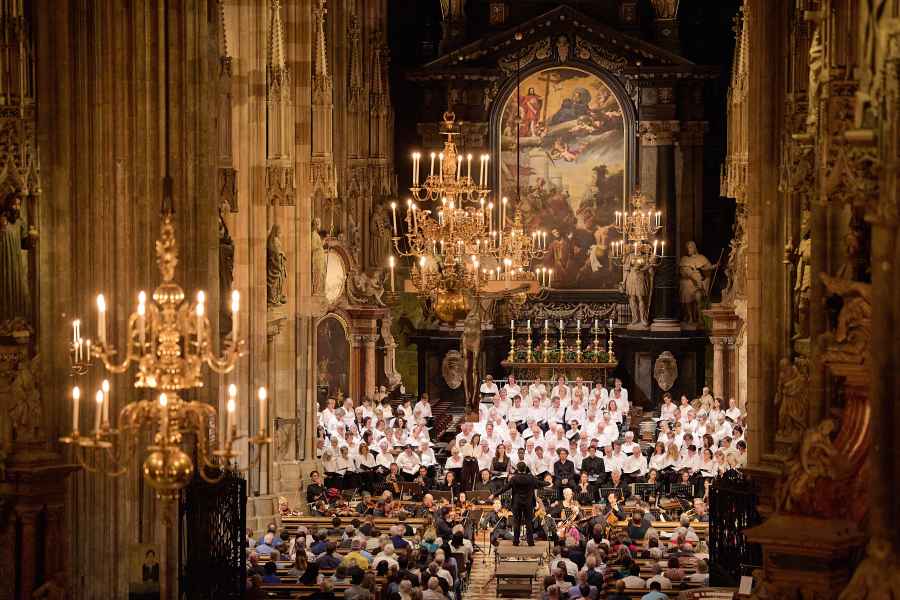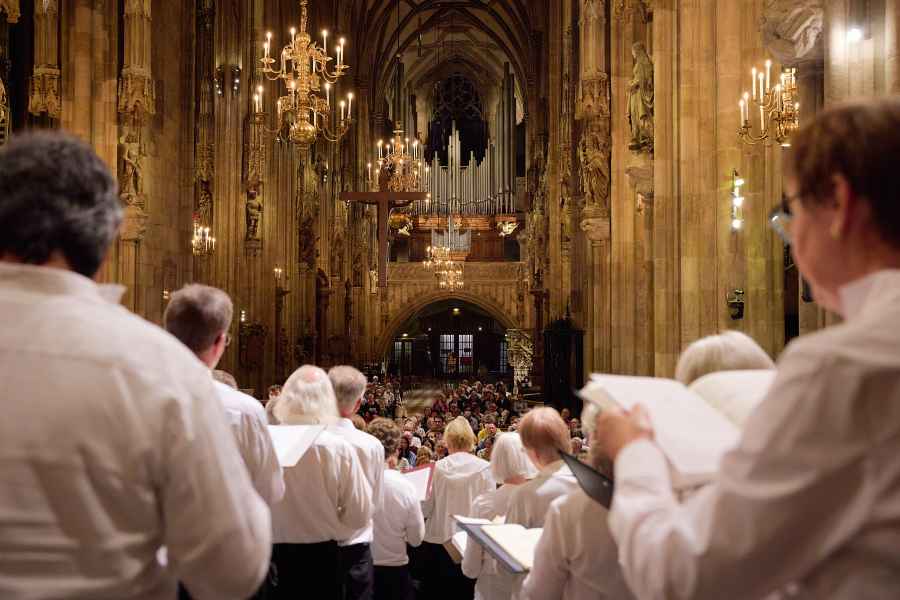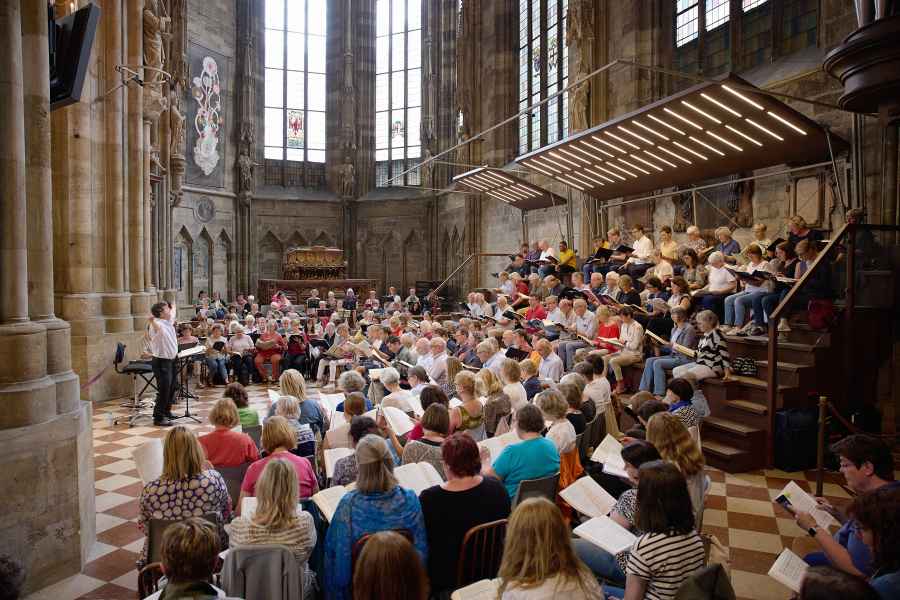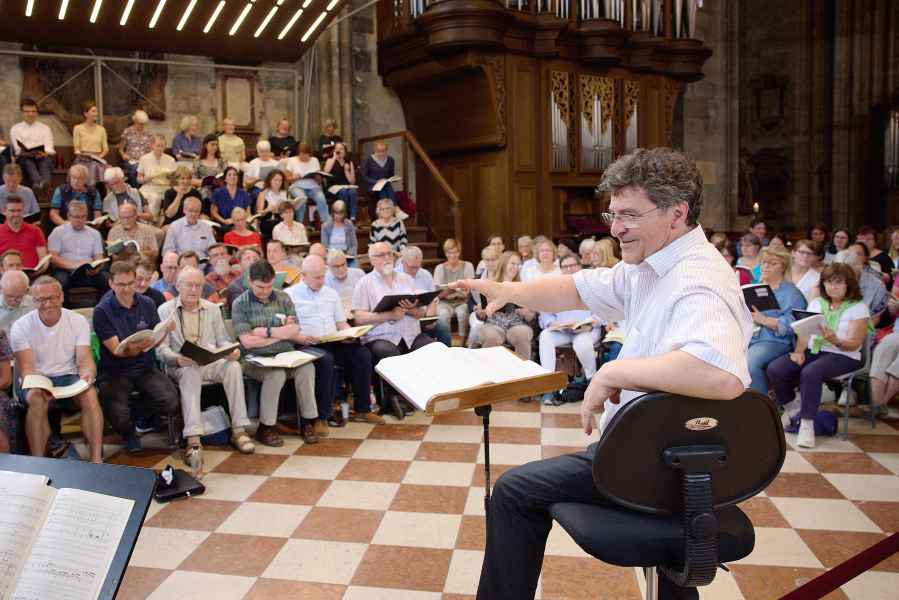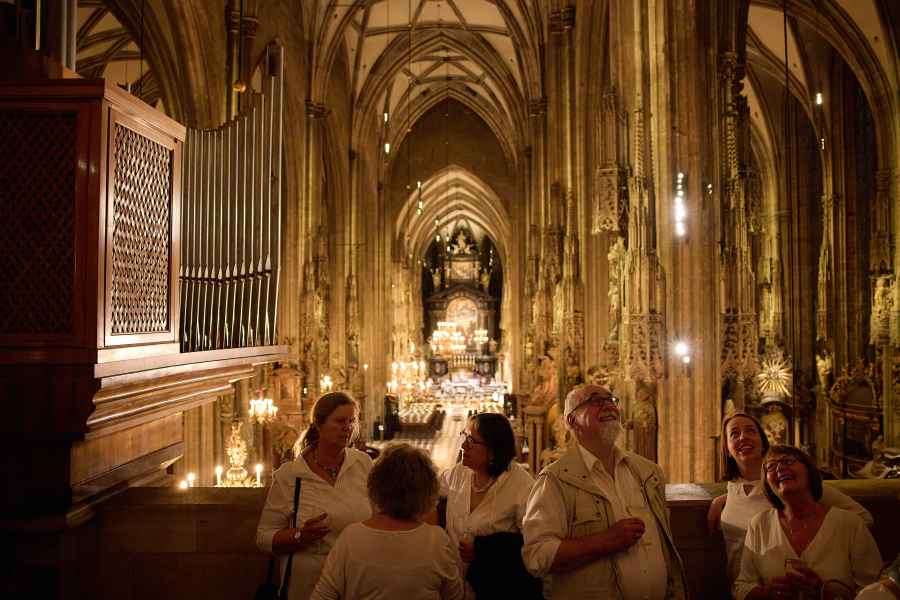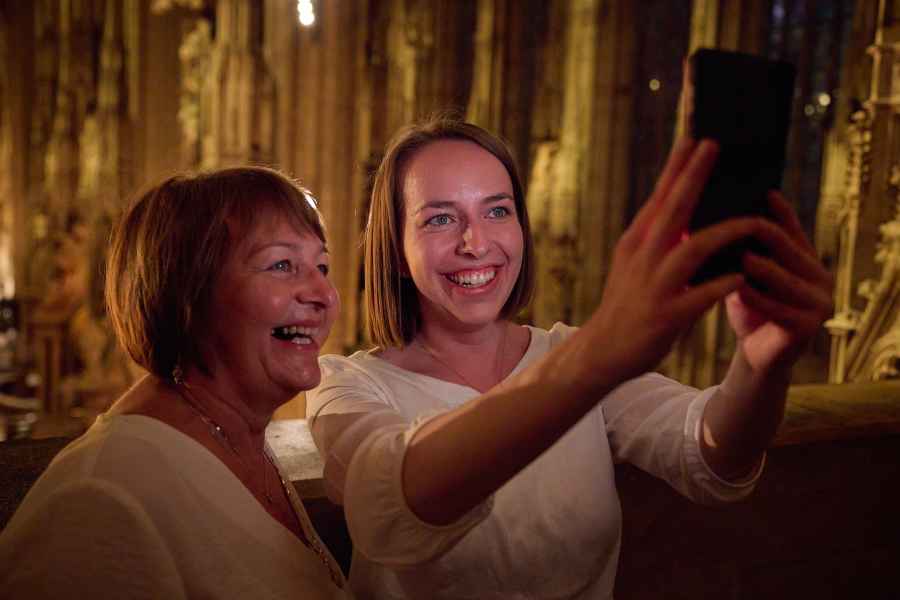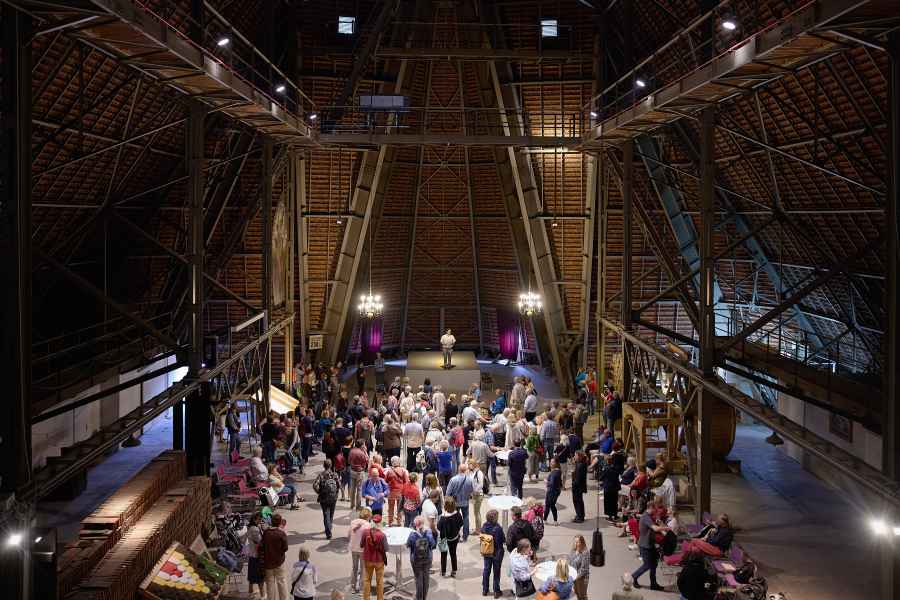Our Sing Along Concerts in Vienna offer individual singers and choirs the opportunity to perform an important work of choral music in Vienna’s St. Stephen’s Cathedral in a professionally organized concert. For 18 years, individual amateur singers and choirs from all over the world come to Austria to be part of this unique Sing Along experience.
Under the direction of a renowned choirmaster you will be studying the relevant piece for several days in rehearsals during the Sing Along! Choir Festival. As part of the Sing Along! Festival Choir newly formed for each piece, you will then perform the work together with your fellow international singers, the Cathedral Orchestra and renowned soloists in a festive final concert in front of a broad audience in Vienna's St. Stephen’s Cathedral.
Meet The Artistic Directors
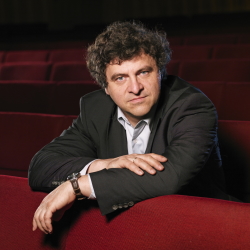
Artistic Director of the Sing Alongs in Vienna
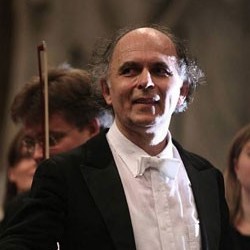
Artistic Director of Sing Alongs
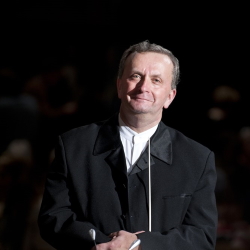
Sing Along! Gallery
G. F. Händel, Messiah
21 to 23 November 2024 | St. Stephen's Cathedral, Vienna
Registration for the Choir Festival is closed as the maximum number of participants has been reached!
You can still order the scores here until July 31.
Sing Händel’s Messiah in English as part of the Sing along! Festival Choir in Vienna's St. Stephen's Cathedral. The work is still one of the most popular examples of sacred music today. Beginning in the first part with the Old Testament prophecies of the prophets, the second part tells the life of Jesus, his birth, his death on the cross - as the fulfilment of the prophecies - and in the third part with the resurrection, the entire story of salvation in the Messiah.
At the Sing along! Choir festival, you will work on the work in English speaking workshops lasting several days under the direction of David Wordsworth, and then perform it together with the Vienna Cathedral Orchestra and renowned soloists as a festive final concert in Vienna's St. Stephen's Cathedral.
Repertoire and Composers
Repertoire
Messiah (HWV 56) - G. F. Händel
Origin
In the mid-1730s, the musical fashion in London changed, moving away from a preference for Italian opera in favour of oratorios and music for the emerging middle class. Seit 1735 entwickelte Händel die Gattung der englischen geistlichen Oratorien, wie z.B. 1738 die Oratorien Saul und Israel in Ägypten und vier Jahre später der Messias – möglicherweise beeinflusste auch eine schwere Erkrankung 1737 (vermutlich ein Schlaganfall) seine Entwicklung in Richtung sakraler Musik. 1741 wurde Händel vom Duke of Devonshire, William Cavendish, nach Dublin eingeladen, um eine Serie von Konzerten zu veranstalten. Für eines der Konzerte wählte Händel die Aufführung eines Oratoriums und schrieb den Messias in konzen-trierter Arbeit binnen 3 Wochen. The idea and the libretto came from Charles Jennens, with whom Handel had been friends for some time.
Story
Jennens takes the approach here - the prophecies of the Old Testament, presented in the first part of Messiah, legitimise the appearance of the Messiah, as subsequently presented in the second part. The third part focuses on the resurrection - thus covering the entire story from the birth to the ascension. The singers do not take on individual roles, nor is there a linear narrative. Instead, Jennens took passages from the Old Testament and structured them to prove that Jesus Christ is the prophet announced in the Old Testament and that his perfection means the redemption of the world.
First Part
The appearance of the coming prophet is prepared by recourse to prophetic texts from the Old Testament by prophets such as Isaiah, Haggai, Malachi and others. For unto us a Child is born is the only part of the Messiah in which the life of Jesus Christ is reported directly.
Second Part
The suffering and death of the Messiah for the sins of the world are also traced here mainly on the basis of the words of the Old Testament, Psalms and prophecies. This is followed by his resurrection and ascension according to Psalms 16 and 24, and Isaiah foretells the good news of eternal salvation. The famous Hallelujah (from the Revelation of John) at the end of the second part forms the triumphant note of the story of death and resurrection, praising the victory of Christianity and the triumph of God. King George II spontaneously jumped to his feet at the premiere, which is why it is still a tradition in Great Britain to listen to this Hallelujah standing up.
Third Part
In contrast to the jubilant Hallelujah, a calm and balanced aria follows at the beginning of the last part as a meditation on the redemptive role of the Messiah and his effect on the individual and the community of believers. Die Texte hier basieren auf dem Buch Hiob, den Korintherbriefen und dem Römerbrief. In the third part, the conclusion Worthy is the Lamb ... is also taken from the Revelation of John, ending in the Amen as a masterfully extended fugue.
The Music
The Messiah, although clearly influenced by church cantatas or sacred concertos, is not church music in the narrower sense. The oratorio was conceived by Jennens as "grand musical entertainment" and was given the character of "entertainment" by Handel's realisation and individualistic elaboration - the performance practice in theatres led to discussions for a long time as to whether such "ill-reputed" performance venues were acceptable for a sacred work.
Impact
The premiere of the Messiah, seven months after its completion, on 13 April 1742 in Fishnamble Street Music Room in Dublin supported three charitable causes - Handel had subsequently always made sure to donate the proceeds of this work to poor and needy people. A year later, on 23 March 1743, the London premiere at the Covent Garden Theatre was less successful. This did not materialise until May 1750 and the concert in aid of the Foundling Hospital. With around 70 performances, the work became one of Handel's most frequently performed pieces during his lifetime. From the mid-1770s, the piece was also performed in German-speaking countries, for example by Carl Philipp Emanuel Bach in Hamburg in 1777. An arrangement by Wolfgang Amadeus Mozart for concerts in Vienna was adopted into performance practice in Austria and Germany in the 19th century.
Composers
George Frideric Handel (1685-1759)
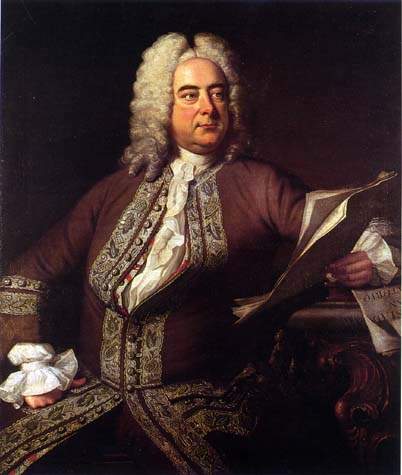
George Frideric Handel was born the son of a respected doctor who had planned a career as a lawyer for him. Initially, Handel played music in secret until his father decided to allow him to study music. He became a pupil of Zachow, the principal organist in Halle. At the age of 18, he travelled to Hamburg, where he played the violin and harpsichord at the opera. In 1706 he travelled to Italy and spent four years in Florence, Rome, Naples and Venice. In all of these cities, he presented his operas and dramatic works, wrote numerous Italian cantatas and perfected his technique of incorporating the Italian language into his works. In Rome, he composed Latin church music.
In 1710, he left Italy and travelled to Hanover, where he became Kapellmeister to the Elector. After a short time, he accepted an invitation and travelled to London, where his opera Rinaldo was produced. In 1712-15 he wrote four more operas, which were received with varying degrees of success. Handel also wrote church music and music for the court. In 1717 he entered the service of the Earl of Carnarvon (later the Duke of Chandos) in Edgware, near London, and composed eleven hymns and two dramatic works: Acis and Galatea and Esther.
In 1718-19, a group of aristocrats tried to popularise Italian opera in London and founded a company under royal patronage, the Royal Academy of Music; Handel, musical director, went to Germany to recruit singers in Dresden for this company, which opened in April 1720. Handel's opera Radamisto marked the beginning of an extremely successful period for the composer.
In the 1730s, Handel, unsure of his commercial and artistic future, switched from Italian opera to the musical forms very common in England, such as the ode or oratorio. After travelling to Dublin in 1741-42, where Handel's Messiah premiered, the composer devoted himself increasingly to oratorio.
During the last ten years of his life, he regularly conducted the Messiah in aid of a hospital for foundlings. Handel died in 1759 and was buried in Westminster Abbey.
Schedule
Thursday, 21 November 2024
Afternoon: rehearsal no. 1
Evening: welcome-reception in the roof atrium of St. Stephen’s
Friday, 22 November 2024
Morning: rehearsal no. 2
Afternoon: rehearsal no. 3
Saturday, 23 November 2024
Morning: dress rehearsal with the Vienna Cathedral Orchestra
Evening: festive concert at St. Stephen's Cathedral
Followed by: concert-reception
Concert in St. Stephen's Cathedral
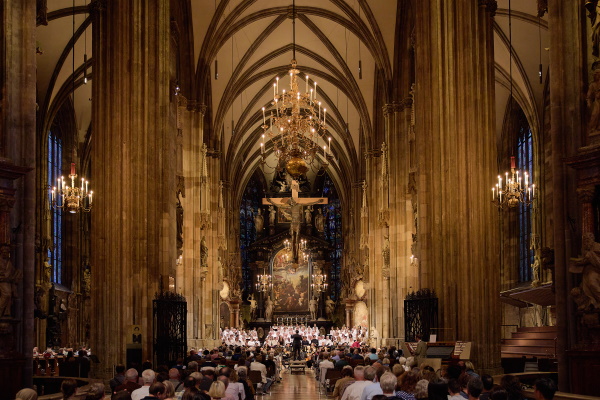
The festive finale of the 42st Sing Along! Choir Festival is the performance of Händel’s Messiah in St. Stephen's Cathedral in front of a grand audience. In this way, you continue the tradition of music in the cathedral and follow in the footsteps of great composers. It was in St. Stephen's Cathedral that Joseph and his brother Michael Haydn received extensive musical training as choirboys. Joseph Haydn married here, as did Johann Strauss and Wolfgang Amadeus Mozart.
For Mozart, St. Stephen's Cathedral played an important role throughout his life, especially when he lived in the nearby Figaro House, but also after his death: He married Constanze Weber here, had two of his children baptized in the cathedral and a few months before his death, Mozart applied for the position of music director adjunct at St. Stephen's. Mozart's name can be found both in the record of his death and in the cathedral's Book of Death Fees.
Apart from Mozart, Antonio Vivaldi, Christoph Willibald Gluck, Antonio Salieri, Franz Schubert and Wolfgang Amadeus Mozart are also recorded here in the Book of Death Fees.
David Wordsworth

English Sing along! Choir Festivals, Artistic Director
David Wordsworth studied at Leeds University, City University (London) and the Guildhall School of Music & Drama. After teaching for some time, he worked for two major music publishers and established contacts with composers such as Tippett, Henze, Ligeti, Penderecki, Dutilleux, John Rutter, Bob Chilcott, Michael Berkeley, Gabriel Jackson and Cecilia McDowall.
In 1995, David Wordsworth took over as director of the Addison Singers and expanded the regular concert series in London. Under his direction, the choir has given concerts in Edinburgh, Paris, Barcelona, Krakow, Milan, and has sung in tours of Cornwall, France, Italy, and New York‘s Carnegie Hall.
David acted as Artistic Director of ‘Singing Shakespeare’, a major project focusing on choirs the world over singing new and existing settings of the Bard. David’s publications include articles on English, American and Polish music, just recently articles on Ralph Vaughan Williams, for ‘Choir & Organ’.
Aside from conducting most of the standard choral repertoire, Handel’s Messiah and Coronation Anthems, the Requiems and Masses of Mozart, Haydn, Schubert, Faure, Verdi, as well as twentieth century classics by Britten, Bernstein, Vaughan Williams, Orff and many others, contemporary music is an important part of David’s programmes.
Vienna Cathedral Orchestra
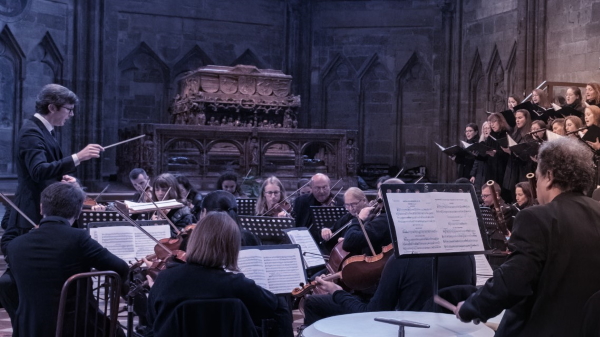 The Vienna Cathedral Orchestra is made up of musicians from all the major Viennese orchestras. The spectrum ranges from chamber music ensembles to the romantic symphony orchestra. At the Sunday High Masses, at many other services organized by the Cathedral Music, at special events and at the concerts of the Cathedral Music, the Cathedral Orchestra is the partner of soloists and choir.
The Vienna Cathedral Orchestra is made up of musicians from all the major Viennese orchestras. The spectrum ranges from chamber music ensembles to the romantic symphony orchestra. At the Sunday High Masses, at many other services organized by the Cathedral Music, at special events and at the concerts of the Cathedral Music, the Cathedral Orchestra is the partner of soloists and choir.
The history of music in St. Stephen's Cathedral probably goes back as far as liturgy has been celebrated in this church, i.e. at least 870 years! The first documented mention of the organized church music is in the abbey letter of Duke Rudolf IV from the year 1365, in which in connection with the establishment of a collegiate chapter (today's cathedral chapter) also a cantor is mentioned, who was responsible for choirmaster, choristers and pupils (Stephaner Sängerknaben). Among the prominent musicians who were active at St. Stephen's Cathedral, Johann Joseph Fux, the brothers Michael and Joseph Haydn, and Wolfgang Amadé Mozart may be mentioned.
Scores and Practicing
You can add the scores for the piece to your registration when booking. We will use the Carus edition at the Sing Along! Choir Festival. Within Europe we will be happy to send the scores to you in early August. Order deadline is July 31st 2024. If you already have the scores or prefer to order them yourself, you can find the edition directly at Carus: Händel Messiah: Carus 55.056/05.
Only parts of the Messiah will be performed: Performance List.
G. Fauré, Requiem
11 to 13 July 2024 | St. Stephen's Cathedral, Vienna
Registration for the Choir Festival is closed as the maximum number of participants has been reached!
The deadline for ordering scores has also passed.
Sing Fauré's Requiem & Cantique de Jean Racine on the occasion of the 100th anniversary of his death as part of the Sing along! Festival Choir in Vienna's St. Stephen's Cathedral. Written between the death of his father and that of his mother, it is a vision of death not in the sense of a sombre funeral, but of happy relief. "It is as meek as myself," Fauré himself later noted.
Under the direction of Prof. János Czifra, Former Domkapellmeister at Salzburg Cathedral, they will study the work over several days in workshops. Afterwards they will perform it as part of the Sing along! festival choir in a large-scale evening concert in Vienna's St. Stephen's Cathedral, accompanied by the orchestra of the Vienna Cathedral Music and renowned soloists.
Repertoire and Composers
Repertoire
Requiem (op. 48) - G. Fauré
In its original form, composed in 1887/88, the Requiem consisted of only five movements: "Introit" with "Kyrie", "Sanctus", "Pie Jesu", "Agnus Dei" and "In Paradisum"; the instrumentation initially envisaged a pure string orchestra (violin only solo) together with harp, timpani and organ. The work was premiered in this form on 16 January 1888 in the Madeleine in Paris. In the spring of the same year, Fauré added two horns and two trumpets to the orchestra; this version was first performed on 4 May 1888. In 1889-92, the composer arranged the Requiem for chamber orchestra, adding the "Offertorium" (composed around 1889-91) and the "Libera me" (newly arranged around 1890/91), which had already been composed in 1877. This "1893 version" was first performed on 23 January 1893, but did not appear in print until 1994. Fauré himself made a further revision of the Requiem in 1894-99, adding woodwinds and violins and thus creating a version for large orchestra, which was first performed on 12 July 1900 and then appeared in print. This version is the generally performed and well-known final form of the work. Although the composition of the Requiem is closely linked to the deaths of Fauré's parents (1885 and 1887), the composer retrospectively emphasised that the composition was written "without an occasion", "for my own pleasure, if I may say so".
In his requiem mass, Fauré left out the violins to a great extent - in the first version they are only provided as soloists - and thus darkened the timbre of the work considerably, concentrating on the elegiac timbre of the respective divided violas and cellos. Characteristic, however, in contrast to most other Requiem settings, is the complete renunciation of theatrical effects and the strong withdrawal of dynamics; instead, Fauré (like Gounod before him) concentrates on a graceful melodiousness of both the choir and the solos. The structure of the Requiem features some striking innovations: for example, Fauré deleted the "Dies-irae" sequence except for the last verse ("Pie Jesu"), but on the other hand added the "In Paradisum", which was originally heard during the transfer of the corpse from the church to the cemetery. Among the few passages that do not radiate seraphic calm is the striking Introit with its multiple contrasts of powerful orchestral unison and restrained choral response, surprisingly revisited towards the end of the Agnus Dei. The Sanctus, with its harp arpeggios throughout, ethereal violin overtones and gentle, lullaby-like vocal cantilenas, is certainly one of the Requiem's most evocative passages; towards the end of the movement, the 'Hosanna' cries are carried by majestic chords and emphatic horn calls. The concluding "In Paradisum", which is reminiscent of Gounod's "Ave Maria" from afar, is similarly enraptured with its prelude-like triadic breaks in the organ, which are taken up by the harp towards the end and lead to a peaceful, if somewhat cloying, conclusion.
Despite its long genesis, the work is stylistically very uniform. "Even stronger than the charm of the Requiem is the lingering impression of the naïve-mystical, of a vision of death not in the sense of a sombre funeral but of a happy relief, not of a painful transition but of a longing for the afterlife" (Marie-Claire Beltrando-Patier). In part, this renunciation of dramatic and abysmal aspects is rooted in Fauré's compositional style, but it also reflects his personal view of death. The composer wrote to Eugène Ysaye that the piece was "of a gentle character, like myself". The Requiem is Fauré's best-known and most frequently performed work in and outside France; it had a far-reaching effect on the development of French church music and clearly influenced Maurice Duruflé, for example. Its relative ease of performance makes it accessible even to amateur choirs.
Composers
Gabriel Fauré (1845-1924)
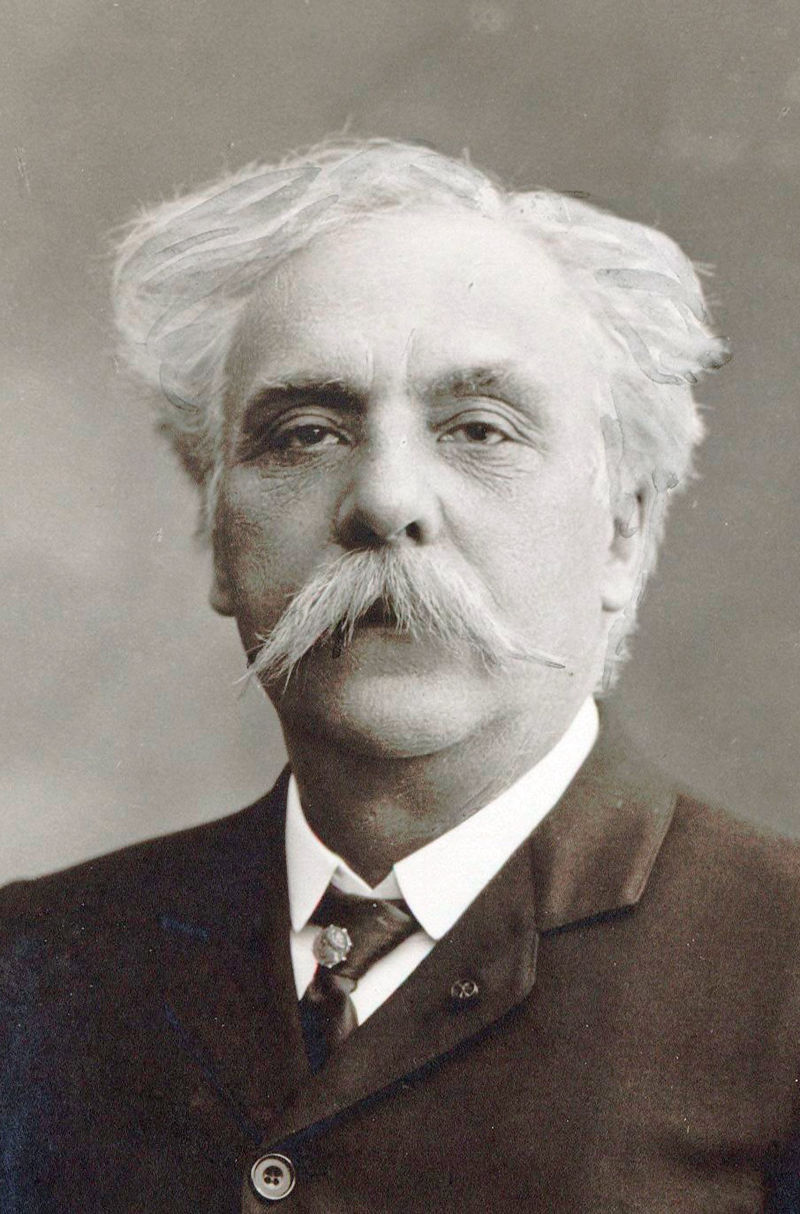
The son of a school headmaster, he grew up not far from Carcassonne at the foot of the Pyrenees. At the age of eight, he was already playing the piano excellently and the following year was accepted at Louis Niedermeyer's Paris school of church music. After Niedermeyer's death, the young Fauré was taken on by Camille Saint-Saëns, 10 years his senior, from 1861. This friendship was to last all their lives. Fauré took part in the Franco-German War of 1870/71 as a courier for an infantry regiment. After his return home in 1871, he was one of the founding members of the Société Nationale de Musique.
Fauré worked as an organist in Rennes and Paris, but was still only able to keep his head above water by working with choirs and teaching piano. When he appeared in the Parisian salons in the evenings, he attracted much admiration as a brilliant improviser on the piano and by his pleasant appearance. In 1892, he was appointed inspector of music education, and in 1896 he was entrusted with the great organ at the Madeleine. In the same year he took up a professorship in composition at the Conservatoire de Paris and from 1901 he taught at the École Niedermeyer. He was director of the Conservatoire from 1905 to 1920, during which time he thoroughly modernised the curriculum. From 1903, Fauré wrote regularly about music in the renowned daily newspaper Le Figaro. In 1920 he received the Grand Cross of the Legion of Honour.
After an unhappy engagement around 1877, Fauré married Marie Fremiet, the daughter of a sculptor, in 1883. This marriage, which produced two sons, was unfortunately unhappy. Around 1900, Fauré fell in love with the 24-year-old pianist Marguerite Hasselmans. This relationship was not concealed, but neither was it legalised by marriage; it lasted until Fauré's death.
If, compared to his contemporary Claude Debussy or his descendant Maurice Ravel, he is not very present in international musical life, it is probably due to stylistic and historical reasons, as well as the fact that he left behind hardly any works with large orchestras. Even his high-profile Requiem was originally written for a meagre instrumentation. The main exception is his music for the play Prométhée, written after Aeschylus. The premiere took place in 1900 in the bullring of Béziers, so to speak in Fauré's south-western French homeland. Several hundred singers and instrumentalists were involved, including 30 trumpeters alone. Fauré managed this "effortlessly", writes R. Crichton. The music showed none of his usual restraint.
According to most connoisseurs, Fauré found the peak of his creativity in vocal music, especially in his piano songs. It is interesting that some of his songs, such as Après un rêve, are known outside France mainly in instrumental arrangements (e.g. for cello and piano). Fauré also wrote chamber music (two piano quartets, piano quintets, violin sonatas, cello sonatas) and piano music.
Gabriel Fauré died of pneumonia in Paris in 1924 at the age of 79. During the funeral in the Madeleine, the composer's Requiem was also performed. He was buried at the Cimetière de Passy.
Schedule
Thursday, 11 July 2024
Afternoon: rehearsal no. 1
Evening: welcome-reception in the roof atrium of St. Stephen’s
Friday, 12 July 2024
Morning: rehearsal no. 2
Afternoon: rehearsal no. 3
Saturday, 13 July 2024
Morning: dress rehearsal with the Vienna Cathedral Orchestra
Evening: festive concert at St. Stephen's Cathedral
Followed by: concert-reception
Concert in St. Stephen's Cathedral

The festive finale of the 41st Sing Along! Choir Festival is the performance of Bruckner’s Mass in D-minor in St. Stephen's Cathedral in front of a grand audience. In this way, you continue the tradition of music in the cathedral and follow in the footsteps of great composers. It was in St. Stephen's Cathedral that Joseph and his brother Michael Haydn received extensive musical training as choirboys. Joseph Haydn married here, as did Johann Strauss and Wolfgang Amadeus Mozart.
For Mozart, St. Stephen's Cathedral played an important role throughout his life, especially when he lived in the nearby Figaro House, but also after his death: He married Constanze Weber here, had two of his children baptized in the cathedral and a few months before his death, Mozart applied for the position of music director adjunct at St. Stephen's. Mozart's name can be found both in the record of his death and in the cathedral's Book of Death Fees.
Apart from Mozart, Antonio Vivaldi, Christoph Willibald Gluck, Antonio Salieri, Franz Schubert and Wolfgang Amadeus Mozart are also recorded here in the Book of Death Fees.
János Czifra

Salzburg Cathedral, Former Domkapellmeister
Prof. János Czifra was born in Budapest in 1951, where he received his basic musical training. After graduating in architecture from the Technical University in Budapest, he was accepted to the Franz Liszt Academy, where he obtained a diploma in choral conducting and music education in 1980. He then began his studies at the Mozarteum Academy of Music, where he graduated in 1982 with a diploma in conducting and later in church music.
He worked as a conductor at the Szent Imre Parish Church in Budapest and at the Györ State Theater (Hungary). He was appointed head of the diocesan church music department in 1983. From 1988 to 2004 he directed the Salzburger Liedertafel. From 1987 to 2022 he was Domkapellmeister at Salzburg Cathedral.
As a conductor, he has given concerts in Europe, America and Japan and is also active as a juror and course director. He has performed with the Salzburg Cathedral Orchestra at the Salzburg Mozart Week, the Salzburg Culture Days and numerous festivals in Germany, Hungary, Italy and Austria.
Vienna Cathedral Orchestra
 The Vienna Cathedral Orchestra is made up of musicians from all the major Viennese orchestras. The spectrum ranges from chamber music ensembles to the romantic symphony orchestra. At the Sunday High Masses, at many other services organized by the Cathedral Music, at special events and at the concerts of the Cathedral Music, the Cathedral Orchestra is the partner of soloists and choir.
The Vienna Cathedral Orchestra is made up of musicians from all the major Viennese orchestras. The spectrum ranges from chamber music ensembles to the romantic symphony orchestra. At the Sunday High Masses, at many other services organized by the Cathedral Music, at special events and at the concerts of the Cathedral Music, the Cathedral Orchestra is the partner of soloists and choir.
The history of music in St. Stephen's Cathedral probably goes back as far as liturgy has been celebrated in this church, i.e. at least 870 years! The first documented mention of the organized church music is in the abbey letter of Duke Rudolf IV from the year 1365, in which in connection with the establishment of a collegiate chapter (today's cathedral chapter) also a cantor is mentioned, who was responsible for choirmaster, choristers and pupils (Stephaner Sängerknaben). Among the prominent musicians who were active at St. Stephen's Cathedral, Johann Joseph Fux, the brothers Michael and Joseph Haydn, and Wolfgang Amadé Mozart may be mentioned.
Scores and Practicing
You can add the scores for the piece to your registration when booking. We will use the Carus edition at the Sing Along! Choir Festival. Within Europe we will be happy to send the scores to you in early April. Order deadline is March 31st 2024. If you already have the scores or prefer to order them yourself, you can find the edition directly at Carus: Fauré Requiem: Carus 27.312/05 & Fauré Cantique de Jean Racine: Carus 70.301/10
A. Bruckner, Mass in D-minor
4 to 6 July 2024 | St. Stephen's Cathedral, Vienna
Registration for the Choir Festival is closed as the maximum number of participants has been reached!
The deadline for ordering scores has also passed.
Perform Bruckner's Mass in D Minor & Locus Iste as a sing-along concert in Vienna's St. Stephen's Cathedral on the 200th anniversary of his birth. Bruckner's 1st Mass is often described as his first true masterpiece and key work, which made him one of those few composers who further developed the symphony after Beethoven and Schubert and decisively shaped the music-making of the 20th century.
At the 40th Sing along! Choir festival, you will work on the work in workshops lasting several days under the direction of Erasmus Baumgartner, assistant artistic director of the Vienna Boys' Choir, and then perform it together with the Vienna Cathedral Orchestra and renowned soloists as a festive final concert in Vienna's St. Stephen's Cathedral.
Repertoire and Composers
Repertoire
Mass in D-minor (WAB 26) - A. Bruckner
Bruckner's first mass composition was actually to be performed for the emperor's birthday on 18 August 1864 - but it was finished too late. It was then premiered on 20 November in the Old Cathedral in Linz and, due to its great success, a performance followed on 18 December in a secular venue: In the Linz Redoutensaal. As there was no organ in this concert hall, Bruckner had to transfer an organ solo to two clarinets and two bassoons.
Bruckner is not a romantic - he merely makes full use of the musical means (harmonisation and instrumentation) and thus fulfils the "romantic requirement". For unlike the other composers of his time, he composed from the deepest faith. Eduard Liszt once said of Bruckner that he was a "minstrel of the Godhead", for his works were professions of faith which even led to his dedicating his last symphony "to the dear God" as an old man - with the additional remark "if He will accept it".
After the successful premiere, he received great praise from all sides. The Wiener Zeitung spoke highly of his Mass and his contemporaries henceforth respected him as a composer of exceptional standing. Even the bishop later explained to Bruckner that he had not been able to preach during the mass because the work had interested and gripped him so much. The most valuable gift for Bruckner, however, was probably that of the government official Mayfeld, an extremely highly educated man and a great lover of music: he honoured Bruckner with a laurel wreath, the ribbon of which bore the inscription: "From the Godhead once proceeded, art must lead to the Godhead again" - this wreath subsequently hung over Bruckner's bed until his death.
In the summer of 1876, after a successful recovery from a nervous illness, Bruckner made rhythmic improvements to his three masses (D minor, E minor, F minor). This resulted in the final version, to which only minor corrections were made later. The work appeared in print for the first time in 1892. This version remains valid to this day.
Composers
Anton Bruckner (1824-1896)
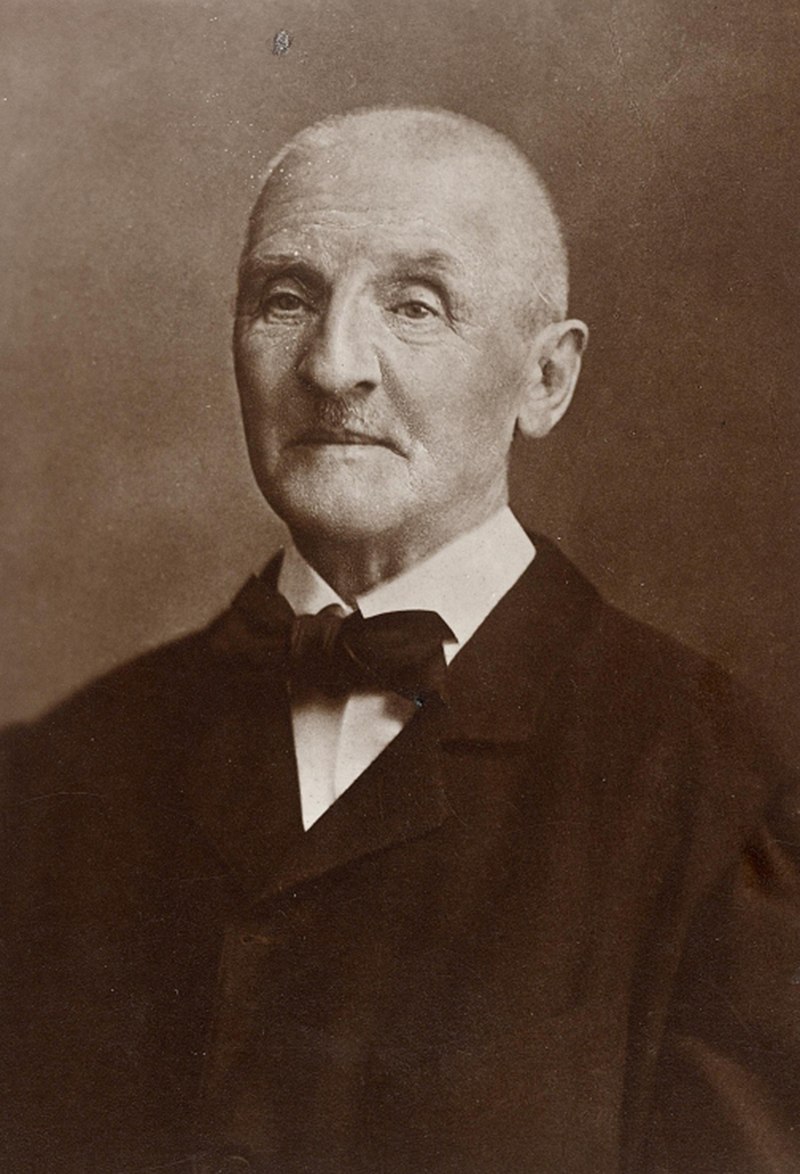
Anton Bruckner did not have it easy. Throughout his life, the Austrian composer was plagued by self-doubt. Anton Bruckner came from a simple, rural background. After the death of his father, he was accepted as a choirboy at the monastery of Sankt Florian in 1837. After several years as a school assistant and self-taught organ and piano studies, he first worked as organist in Sankt Florian, then from 1855 as cathedral organist in Linz. Introduced to music theory and instrumentation by Simon Sechter and Otto Kitzler, he discovered Richard Wagner as an artistic role model, whom he admired throughout his life and visited several times in Bayreuth.
In 1868 Anton Bruckner became professor of basso continuo, counterpoint and organ at the Vienna Conservatory, ten years later court organist, and finally in 1891 honorary doctor of the University of Vienna. He was considered an important organ virtuoso of an era, but had to wait a long time for recognition as a composer. It was not until the "Symphony No.7, E major", composed between 1881 and 1883, with the famous "Adagio" written under the impression of Wagner's death, that the hoped-for recognition came, even if he did not want to accept it in view of his tendency to scepticism and self-criticism.
Anton Bruckner was a loner who did not want to follow any school or doctrine. He composed numerous sacred vocal works such as his three masses, the "Missa Solemnis in B flat minor" (1854), the "Te Deum" (1881-84) and numerous motets. As a symphonist, he wrote a total of nine symphonies and many symphonic studies from 1863 onwards, tending to revise finished versions several times. Bruckner's orchestral works were long considered unplayable, but were merely unusually bold for the tonal language of their time, uniting traditions from Beethoven to Wagner to folk music, sound monuments on the border of late Romanticism and modernism.
Schedule
Thursday, 4 July 2024
Afternoon: rehearsal no. 1
Evening: welcome-reception in the roof atrium of St. Stephen’s
Friday, 5 July 2024
Morning: rehearsal no. 2
Afternoon: rehearsal no. 3
Saturday, 6 July 2024
Morning: dress rehearsal with the Vienna Cathedral Orchestra
Evening: festive concert at St. Stephen's Cathedral
Followed by: concert-reception
Concert in St. Stephen's Cathedral

The festive finale of the 40th Sing Along! Choir Festival is the performance of Bruckner’s Mass in D-minor in St. Stephen's Cathedral in front of a grand audience. In this way, you continue the tradition of music in the cathedral and follow in the footsteps of great composers. It was in St. Stephen's Cathedral that Joseph and his brother Michael Haydn received extensive musical training as choirboys. Joseph Haydn married here, as did Johann Strauss and Wolfgang Amadeus Mozart.
For Mozart, St. Stephen's Cathedral played an important role throughout his life, especially when he lived in the nearby Figaro House, but also after his death: He married Constanze Weber here, had two of his children baptized in the cathedral and a few months before his death, Mozart applied for the position of music director adjunct at St. Stephen's. Mozart's name can be found both in the record of his death and in the cathedral's Book of Death Fees.
Apart from Mozart, Antonio Vivaldi, Christoph Willibald Gluck, Antonio Salieri, Franz Schubert and Wolfgang Amadeus Mozart are also recorded here in the Book of Death Fees.
Erasmus Baumgartner
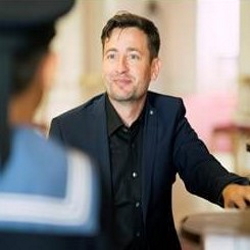
Vienna Boys Choir, Assistant Artistic Director
Erasmus Baumgartner received his first musical training as a choirboy at St. Florian Abbey in Upper Austria. At the age of 17, he began studying conducting and singing at the Anton Bruckner Private University in Linz, from which he graduated with distinction in 2002. He later completed a master's degree in instrumental and vocal pedagogy at the Mozarteum University in Salzburg, also with distinction.
Erasmus Baumgartner has taught at music schools and grammar schools, with the Vienna Boys' Choir and at the Vienna State Opera.
As a chorister, he sang at the Salzburg Festival: in 1987 as a choirboy under Herbert von Karajan and in 2008 as an adult under Seiji Ozawa and Franz Welser-Möst. While still a student, Baumgartner founded the internationally acclaimed "Academy Singers", a choir of 50 young singers from all over Upper Austria. From 2009 to 2012, he was the Artistic Director of the Juvenis choir in Schärding.
He has been working intensively with the soloists of the Vienna Boys' Choir since 2010.
Vienna Cathedral Orchestra
 The Vienna Cathedral Orchestra is made up of musicians from all the major Viennese orchestras. The spectrum ranges from chamber music ensembles to the romantic symphony orchestra. At the Sunday High Masses, at many other services organized by the Cathedral Music, at special events and at the concerts of the Cathedral Music, the Cathedral Orchestra is the partner of soloists and choir.
The Vienna Cathedral Orchestra is made up of musicians from all the major Viennese orchestras. The spectrum ranges from chamber music ensembles to the romantic symphony orchestra. At the Sunday High Masses, at many other services organized by the Cathedral Music, at special events and at the concerts of the Cathedral Music, the Cathedral Orchestra is the partner of soloists and choir.
The history of music in St. Stephen's Cathedral probably goes back as far as liturgy has been celebrated in this church, i.e. at least 870 years! The first documented mention of the organized church music is in the abbey letter of Duke Rudolf IV from the year 1365, in which in connection with the establishment of a collegiate chapter (today's cathedral chapter) also a cantor is mentioned, who was responsible for choirmaster, choristers and pupils (Stephaner Sängerknaben). Among the prominent musicians who were active at St. Stephen's Cathedral, Johann Joseph Fux, the brothers Michael and Joseph Haydn, and Wolfgang Amadé Mozart may be mentioned.
Scores and Practicing
You can add the scores for the piece to your registration when booking. We will use the Carus edition at the Sing Along! Choir Festival. Within Europe we will be happy to send the scores to you in early April. Order deadline is March 31st 2024. If you already have the scores or prefer to order them yourself, you can find the edition directly at Carus: Bruckner Mass in D-minor: Carus 27.092/05 & Bruckner Locus Iste: Carus 3.058/20
Stay Up To Date
Our newsletter keeps you well informed about the Sing Along! Choir Festivals.
Frequently Asked Questions
Tell me About the Sing Along! Choir Festivals?
The Sing Along! Choir Festivals are Sing Along Concerts, where important pieces for choir and orchestra are performed. The Sing Along! Festival Choir, which is newly formed for each piece, is composed of individual singers and choirs from all over the world, who register for a Choir Festival and prepare the respective work at home in advance. In several-day rehearsals with a renowned choirmaster, the fine-tuning takes place before the work is performed with a professional orchestra and renowned soloists in Vienna's St. Stephen's Cathedral or Salzburg Cathedral.
Who Can Participate in the Sing Along! Choir Festivals?
For the Sing Along! Choir Festivals both entire choirs and individual singers, both amateur singers and long-standing professionals can register. The singers rehearse the work in advance, the fine tuning is done in the rehearsals.
Can Groups and Choirs Register As Well?
We are also very happy to welcome groups and choirs to the Sing Along! Choir Festivals. For choir and group inquiries please contact us by e-mail to This email address is being protected from spambots. You need JavaScript enabled to view it.! You can also register your group or choir directly via our Online Registration System, in which case we will contact you with the details of your singers.
In Which Languages are the rehearsals Held?
Music is the universal language we all speak. Nevertheless, the rehearsals of the Sing Along! Choir Festivals are held bilingually in German and English. In 2024, the workshops for Messiah will be held in English.
Which Services are Included in the Participation Fee?
The participation fee includes the following services:
All rehearsals
Reception in the roof atrium of St. Stephen's Cathedral / in the Domchorsaal
Festive final concert in St. Stephen's Cathedral / Salzburg Cathedral
Reception after the concert with all artists
As a memory, 1 poster and 1 programme booklet mentioning the name of each participant
Are Auditions Necessary for Participating in the Sing Along! Choir Festivals?
We trust in your ability to judge whether you are capable of singing the respective choral piece. Should you be in doubt please write to This email address is being protected from spambots. You need JavaScript enabled to view it..
Do I have to prepare the work at home?
Yes, it is necessary that you prepare with the scores at home, in the rehearsals the finishing touches are made. Many choir singers use Carus Music / Choir Coach or other practice parts to rehearse the works.
Is the Number of Participants Limited?
Yes, the number of participants is limited depending on the piece performed. Registrations will be considered after receipt.
How Much is the Participation Fee?
The participation fee for the Sing Along! Choir Festivals in 2024 is € 120,- until December 31st 2023 (Early bird discount) and € 130,- from January 1st 2024.
Will the Scores for the Respective Piece be Sent Out?
Within Europe we will be happy to send you the appropriate scores in early April, which you can add to your registration. The order deadline is March 31st 2024. The costs for the scores and their shipping for the Sing Along! Choir Festivals are:
Bruckner Mass in D-Minor: € 19,-
Bruckner Locus Iste: € 5,-
Fauré Requiem: € 14,-
Fauré Cantique de Jean Racine: € 8,-
Händel Messiah: € 19,-
If you already have the scores or prefer to order them yourself, the publisher for all scores is Carus-Verlag:
Bruckner Mass in D-minor: Carus 27.092/05
Bruckner Locus Iste: Carus 3.058/20
Fauré Requiem: Carus 27.312/05
Fauré Cantique de Jean Racine: Carus 70.301/10
Händel Messiah: Carus 55.056/05
Are Combi Reductions Available for Several Sing Along! Choir Festivals?
Many of our participants sign up for more than one Sing Along! Choir Festival. In this case you benefit from the following discounts.
Participation in two choir festivals: You receive a 10% discount on the participation fee
Participation in three choir festivals: You receive a 15% discount on the participation fee
What are the Cancellation Conditions?
Should you wish to cancel your fixed participation in the Sing Along! Choir Festival 2022, the following cancellation conditions apply.
until 8 weeks before the choir festival: € 20,- cancellation fee
8 - 4 weeks before the choir festival: 50 % cancellation fee
3 - 1 weeks before the choir festival: 75 % cancellation fee
from 1 week before the choir festival: 100 % cancellation fee
In case of travel restrictions or a lockdown your cancellation and the refund are of course free of charge.
These cancellation conditions also apply to online bookings of your participation. The message "Tickets purchased online cannot be cancelled" displayed during the online booking process is an automated message that we unfortunately cannot change to the above cancellation conditions.
Please request the cancellation conditions for groups (from 10 persons) separately under This email address is being protected from spambots. You need JavaScript enabled to view it.
How does the Online Registration Work?
Via our Online Registration System you can complete your registration and also pay directly. The following steps are necessary:
-
Add a Registration Fee to the shopping cart, including scores if you need any. If you add a Combi-Registration for 2 choir festivals to your shopping cart, please choose your combination in the next step.
-
After you have chosen "Checkout", enter your data in the contact form. If you want to make a Combi-Registration for 2 choir festival participations please choose your desired combination here.
-
Click "Continue" to proceed to the online payment by bank transfer or credit card. After you have clicked on "Place Order and Charge my Account" you can complete the order.
-
You will receive an automated confirmation by e-mail, which also includes an Online Ticket that you can take with you to the Choir Festival as confirmation of your registration. Please note that you will only receive one Online Ticket, even if you have registered for a Comb-Registration; you are still registered for the Choir Festivals of your choice.
-
To provide you with a contact person in case of questions, we will nevertheless contact you personally.
I Made an Online Combi-Registration but Only Got One Ticket - am I Registered for Both or all 3 Choir Festivals?
Due to system restrictions it is unfortunately not possible to issue more than 1 ticket for an online combi-registration. In the lower part of the Online-Ticket you will find the combi-registration for 2 or 3 Choir Festivals indicated and you can take the ticket to both or all 3 events as confirmation. In our participant lists you are noted accordingly in any case.
How to Register by E-Mail?
You can also register by e-mail to This email address is being protected from spambots. You need JavaScript enabled to view it..Simply send us the completed registration form:
Registration form Händel Messiah Vienna

